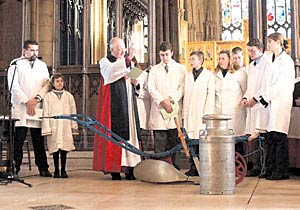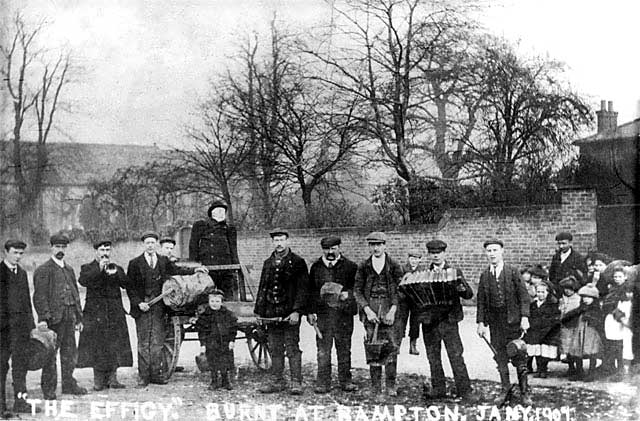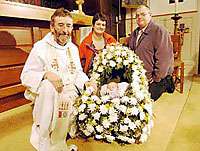
 |
Blessing the Plough at Newark on Plough Sunday. Newark Advertiser, 2001. |
Graphic
Photographic
Two large general sources of photographs are the local press and the picture collections in local libraries. The press, especially the small-town press, is particularly good at picturing the commonplaces of the folklore calendar around Christmas, New Year, Easter and so forth. For instance, the likes of the Eastwood and Kimberley Advertiser are usually awash with pictures of school and social groups in Easter bonnets at the relevant time of year. The more uniquely local customs such as Nottingham’s Goose Fair, the Wellow May Day, the Blidworth Rocking Ceremony and Laxton Jury Day and Court Leet may get more special treatment. Thus, the Newark Advertiser regularly gives a big splash, often on the front page, to the annual Plough Sunday service, with photographs of the plough being carried in procession from the Town Hall to Newark Parish Church or being blessed by the bishop.
In the early 20th century, photographs in the press were less common than they are today, and folklore-related events would need to be rather special and newsworthy to warrant coverage. Therefore any photographs from this era can be particularly interesting, especially if they portray a custom or activity that has since died out.
A potential problem with press photographs is that they are printed using a half-tone process that does not usually lend itself to further reproduction. Copying with a modern digital photocopier may make things worse by overlaying a Moiré pattern caused by the dots that make up the original picture interacting with the dots used in the digital copying process. Most newspapers and magazines allow readers to buy original prints and may even publish reference numbers next to the picture to facilitate ordering. However, these facilities are usually only available for a limited period of time. Some photographs may nowadays also be reproduced in online versions of the newspaper, and in theory these could be saved to local computers. However, they are normally only available for a short time, such as a week, and the picture quality tends to be kept to a minimal standard so as not to undermine their hardcopy services.
Arguably the best sources for original photographs are the collections at the Nottingham Local Studies Library, in Local Studies collections at branch libraries, and in Manuscripts and Special Collections at the University of Nottingham. These, along with images from Derbyshire are being made available online through the major Picture the Past project (www.picturethepast.org.uk or www.picturethepast.co.uk), although it must be admitted that folklore is only a small part of the Picture the Past database. Searching for a particular place name should turn up any folklore-related pictures. More generally, it is worthwhile searching for terms such as ‘customs’, ‘maypole’, ‘May Day’, ‘Whitsun’ (for Whitsuntide Walks), ‘games’, ‘ran-tanning’, and so on. The results will become more rewarding as the database continues to grow.
One of the jewels in the Picture the Past database is a very rare, if not unique photograph of ‘Ran-tanning’ in Rampton, dated 1909. “Ran-tanning” was a form of folk law, known more generically to folklorists as ‘Rough Music’. If someone was judged by the community to have offended moral norms, for instance by beating their wives, the populace would equip themselves with pots, pans, kettles or anything that could create a racket, and parade an effigy to the offending household, usually on three successive nights, after which the effigy might be burned. The practice was surveyed nationally by the renowned social historian E.P.Thompson (1991), although disappointingly he did not include any of the well-documented examples from Nottinghamshire (e.g. see C.Brown, 1874, pp.81-83). Thompson would have given his eye teeth for the Rampton photograph because he could only illustrate his chapter with artistic representations. Because it was a form of vigilantism and likely to provoke public disorder, Ran-tanning and similar activities were banned under the Highways Act 1882, so the incident in the photograph was therefore illegal at the time it was taken.

‘Ran-Tanning’ at Rampton, 1909. Picture the Past. Courtesy of Nottinghamshire County Council.
In addition to the general image resources there are a few specialist resources that are of particular interest:
The National Fairground Archive at the University of Sheffield holds a large collection of images and ephemera (www.shef.ac.uk/nfa). Its coverage naturally includes Nottingham’s Goose Fair as well as other local fairs and wakes. This archive has been built largely from the point of view of the showmen, providing a counterpoint to the more familiar accounts of city officials and the general public.
Doc Rowe has been photographing and filming seasonal customs the length and breadth of the country for forty years or more, and has become something of a national institution in his own right. His Archive and Collection - www.docrowe.org.uk - includes material on the Blidworth Rocking Ceremony, Nottingham Goose Fair, and Laxton Jury Day.
 |
Blidworth Rocking Ceremony, Mansfield Chad, 2008. |
The commercial Collections Picture Library’s Folk Customs List includes photographs of the Cradle Rocking, Blidworth, Nottingham Goose Fair, Jury Day and Court Leet at Laxton, the Wellow Maypole, and the one-off Royal Maundy Service at Southwell Minster - www.collectionspicturelibrary.com/folkcustoms.html.
Lastly, the Folk Play Research website includes numerous recent photos of Nottinghamshire folk plays, and of one of the last traditional Guysers groups at Brinsley, 1971 – www.folkplay.info/Gallery/Photographs.htm.
Film and video
The Nottingham Local Studies Library holds films and videos, some of which include folklore material. One such is a video of the Blidworth Plough Monday play recreated by pensioners who had performed the play in their youth.
The Media Archive for Central England (MACE - www.macearchive.org) includes material on Nottingham Goose Fair, and no doubt will acquire more folklore-related items as the archive grows. MACE features on the Moving History website (www.movinghistory.ac.uk/archives), which provides a national guide to UK film and television archives in the public sector.
One cannot finish discussing film and video resources without mentioning the countless commercial Robin Hood movies that have been produced. While they are of little historical merit, they contribute to the continued evolution of the Robin Hood legend and may be of academic interest in the future.
Artistic
The artistic representation of Nottinghamshire folklore is an area ripe for research. Many of the tales of Robin Hood and of the Wise Men of Gotham have been illustrated in print with woodcuts, drawings and paintings, and these have also been the subject for pub signs. Nottingham Goose Fair has been a subject for various artists, for instance Arthur Spooner and Joseph Appleyard. Of more documentary interest is a painting of the Nottingham Races in 1865 by John Holland, in the collection at Nottingham Castle Museum. This shows various games and activities taking place among the crowd, including an ‘Aunt Sally’ stall and a group of negro minstrels. One unusual item is a topical cartoon by M.O.T. in Nottinghamshire Countryside, which benignly lampoons the 1939 revival of the plough play at Cropwell Bishop.
Music
The prime resource for Nottinghamshire folk songs and music is the Vaughan Williams Memorial Library (VWML) housed at Cecil Sharp House, London, the headquarters of the English Folk Dance and Song Society. A catalogue of its materials is increasingly being made available through VWML Online (library.efdss.org). You can search for Nottinghamshire as a source of collected material, or as occurring in song titles, first lines, etc.
The Nottingham Local Studies Library (NLSL) holds the scores of some local carols and folk songs, a few of which are in manuscript. The specific Christmas carolling tradition in Beeston is covered in a CD, cassette and booklet by Ian Russell (1997). The booklet includes words and musical scores.
Broadsheet ballads (also called broadsides), chapbooks and similar street literature of the 19th century and before are of particular interest to students of folk song (and of Robin Hood), since these were often the original sources for lyrics. The NLSL has a small collection, as does the University of Nottingham Library. One especially useful online resource is the Bodleian Library Broadside Ballads, a collection of over 30,000 ballads from several major collections, and hosted by the University of Oxford (www.bodley.ox.ac.uk/ballads). This database is searchable by title and first line of the ballad, as well as by subject, publisher, and date. It displays high resolution images of the original broadsides. Note that these are often large files that take a while to download. Also, there are usually multiple editions of the same ballad.
References
- M. O. T. (1939) Our Special Cartoonist Visits Cropwell Bishop. Nottinghamshire Countryside, Jan.1939, p.26
- Ian Russell (1997) Brightest and Best: Village Carols from Beeston in Nottinghamshire. Unstone: Village Carols, 1997. [CD and C49 audio cassette, VC010, with 48 pp. book.]
- E.P.Thompson (1991) Customs in Common. London: Merlin Press, 1991